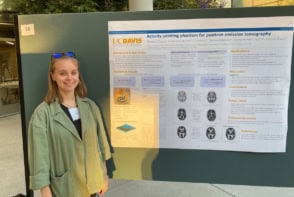Particle beams treat abnormal heart rhythms
Researchers from the Mayo Clinic have described methods for using particle therapies, such as carbon-ion therapy, to treat abnormal heart rhythms by targeting and ablating their source (WO/2019/046732). The technique can be used to treat atrial fibrillation and ventricular tachycardia, for instance, as well as hypertension, seizures and gastrointestinal maladies. The accelerated particles can create tissue lesions sufficient to eliminate abnormal heart rhythms, and could also be safer for patients by avoiding organ damage that occurs, for example, with catheter-based ablation. Contouring and gating may be used to account for cardiac and respiratory motion, helping to reduce collateral damage.
Targeted radiotherapy drives anti-tumour immune response
A team at the University of Wisconsin–Madison has developed a method for treating one or more malignant solid tumours using targeted radiotherapy (TRT) to drive anti-tumour immune response to immunotherapies (WO/2019/094657). The treatment first involves systemically administering an immunomodulatory dose of a TRT agent, such as a radioactive metal chelate compound, radiohalogenated compound, radiolabelled antibody or a radioisotope that’s differentially taken up by and retained within solid tumour tissue. Next, immunotherapy is performed via systemic administration of an immunostimulatory agent, such as one or more immune checkpoint inhibitors.
Laser-based design enhances ion beam generation
HIL Applied Medical has published details of methods for generating ion beams, including proton beams (WO/2019/074497). Such systems may incorporate a beam of electromagnetic radiation directed onto an ion-generating target to create a proton beam. A detector measures at least one laser–target interaction property, which is used by a processor to produce feedback to adjust the proton beam. The system may also include an electromagnet and an automated switch to filter the energy of a pulsed ion beam and/or provide pulsed ion radiation at desired times. According to the filing, such systems reduce the size, complexity and cost of proton beam generation, while improving speed, precision and configurability. Within proton therapy, the systems enable shorter treatment times, higher patient throughput, more precise treatment of the desired areas and less damage to healthy tissue.
Biofeedback enables self-positioning during radiotherapy
Opus Medical has invented a patient-guided stereoscopic surface imaging and biofeedback system for self-positioning during radiotherapy (WO/2019/072950). The set-up includes a patient couch mounting system, an array of at least two imaging sensors (a camera, or infra-red or ultrasound imager) for imaging the patient at multiple viewing angles and a viewing screen that displays images from the sensors. The sensors, viewing screen and controller are configured to output 3D surface information of the patient under test, extrapolated 2D patient position information and 1D patient position information. The screen, which displays patient position boundary markers overlaid on the images from the sensors, is positioned to be viewable by the subject on the patient couch, to provide biofeedback during radiotherapy. This biofeedback informs the patient of a correct position to adjust to and to maintain during treatment.
Keeping track of cavitation during focused ultrasound
INSIGHTEC has devised methods for accurate detection of cavitation signals from a target during a focused ultrasound procedure, without requiring large numbers of cavitation detectors. Such monitoring can help minimize any undesired effects of microbubble cavitation (WO/2019/058171). The approach involves placing a limited number of cavitation detection devices in contact with the patient’s scalp at regions with high transmission efficiency for cavitation signals. The transmission efficiency for each scalp region is computed based on the predicted beam path from the target through the skull and scalp, and anatomical characteristics of the scalp and/or skull in the intercepted regions, which may be acquired via imaging. The detector locations may also be selected by considering characteristics such as the geometry of the scalp and skull.
Superconducting cyclotron enables compact proton therapy system
Hefei CAS Ion Medical and Technical Devices of China has designed a compact proton therapy system comprising a superconducting cyclotron, an energy selection system, a beam transport system, a dedicated treatment room and a rotatable machine support frame (WO/2019/071977). The superconducting cyclotron delivers a fixed-energy proton beam that is converted by the energy selection system to adjust the beam energy from 70 to 200 MeV, thereby achieving longitudinal beam range adjustment during tumour treatments. The superconducting cyclotron, energy selection and beam transport systems, and the treatment head cooperate to control and achieve transverse expansion of the proton beam, enabling conformal and intensity-modulated radiation therapy.



